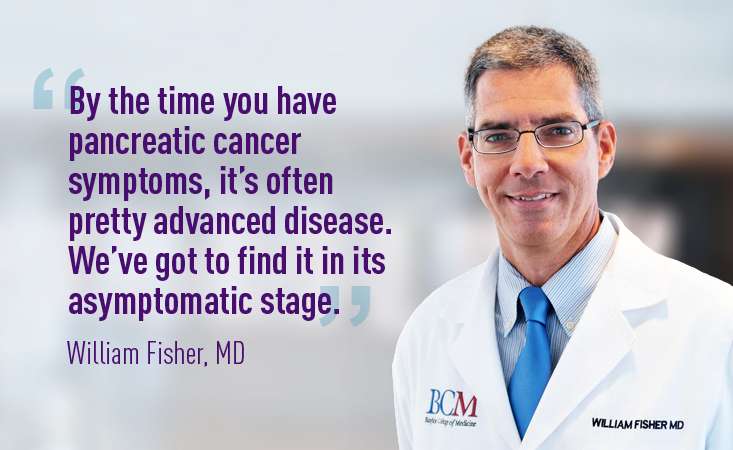
As a surgeon and director of the Elkins Pancreas Center at Baylor College of Medicine, William Fisher, MD, knows how important it is to diagnose pancreatic cancer as early as possible – to give patients every chance at a successful outcome.
For decades, he’s been leading research to find an early detection strategy that is effective.
“I’m hopeful that there is lead time that we can gain with pancreas cancer,” he said. “The symptoms of pancreas cancer are vague, and by the time you have symptoms, it’s often pretty advanced disease. We’ve got to find it in its asymptomatic stage.”
Several recent developments in the field show promise, he said, and make him more optimistic than ever that there is a way forward.
Recently, he’s been learning more about private companies developing tests to detect many different types of cancer, including pancreatic. The sheer number of ongoing projects infuses energy and new ideas into the space.
Just a sampling of some of the avenues being explored: How to harness circulating free DNA to detect cancer earlier; whether changes in saliva or stool could be measured to find cancer at its earliest stages; and what clues the microbiome (bacteria and other small organisms found in the body) may hold when it comes to cancer detection.
To see any of these promising leads through, we’ve got to think differently about the research enterprise, Dr. Fisher said. We need rigorous science alongside rapid innovation. This may take the form of clinical trials conducted by academic institutions, with industry partners providing the technology or platform to be tested.
“I’ve learned over my career that to take something from an idea to a discovery that looks promising is a rare thing,” he said. “Then to take that discovery and translate it into something that’s actually clinically useful is another enormous hurdle. Things often fail when you get to that point. So I don’t think we should shy away from partnering with private companies. You just have to do it right.”
Artificial Intelligence and Imaging
Another exciting recent development: The potential that artificial intelligence (AI) brings to pancreatic cancer early detection, particularly when it comes to imaging.
“Traditionally, a radiologist looks at the CT scan and tries to see something abnormal,” he said. “In early stage disease, it can be subtle. You don’t really see a mass, but maybe there’s a change in the diameter of the duct or something like that. Real subtle signs. But a computer looks at the CT scan very differently. It is looking at pixels and data.”
That same image, when evaluated by AI-trained computers, could pick up what the human eye may miss, leading to diagnosis at a stage that opens more treatment options.
Taken together, new tests and the continued development of AI may be important pieces of the puzzle, Dr. Fisher said.
“If you had a good, cheap blood test to screen your at-risk population, and then you go get a CT scan that’s read by AI, maybe that’s how we do it,” he said.
New-Onset Diabetes and PanCAN’s Early Detection Initiative
Then, there’s the challenge of figuring out who is at higher risk for the disease. Since pancreatic cancer is relatively rare compared to many other types of cancer, it’s important to find the individuals who would most benefit from additional screening, as the current options aren’t easy and are very expensive to access.
Through a national consortium of pancreas centers, Dr. Fisher has been looking at whether a diagnosis of new-onset diabetes may help to identify people at risk for pancreatic cancer.
The study uses an algorithm to identify through electronic health records people over the age of 50 with a new diagnosis of diabetes. They then track for three years how many go on to develop pancreatic cancer.
Results are compelling: Not only is new-onset diabetes associated with an increased risk of pancreatic cancer, particularly for non-Hispanic white individuals, the lead time between the diabetes diagnosis and cancer development may be enough to intervene early. Researchers are also collecting blood samples pre- and post-diagnosis, which sets them up to explore whether a biomarker exists to help predict pancreatic cancer.
PanCAN’s Early Detection Initiative also explores the connection between new-onset diabetes and pancreatic cancer but with an added step: imaging. Dr. Fisher plays a lead role as principal investigator at Baylor. One goal is to determine whether performing imaging at the time of new-onset diabetes helps to diagnose pancreatic cancer earlier in this high-risk group. He’s bringing new methods to this work to encourage participation. Instead of asking patients to make visits to Baylor, his team offers to perform scans at their primary care providers.
For Dr. Fisher, all of these advances give him hope. Although pancreatic cancer is a difficult disease, he’s committed to bringing his patients the very best care – now and in the future.
“I would love to participate in something that leads to an early diagnostic test that actually works,” he said.
















